What You're Really Eating When You Order White Castle Fish Sliders
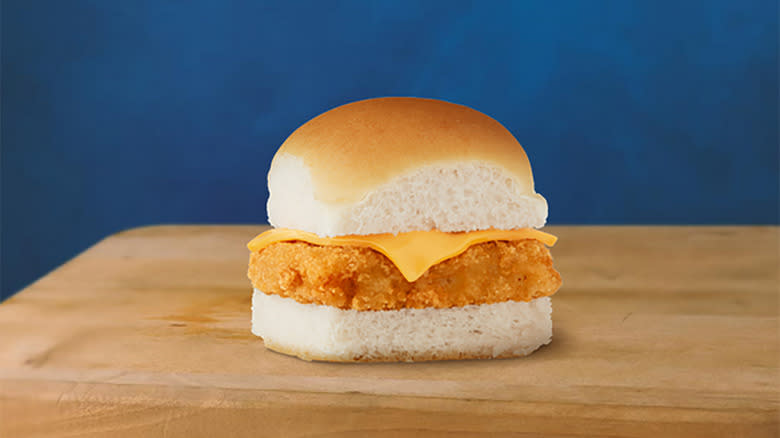
White Castle first introduced its fish slider in 2020, adding a seafood option to the menu for its fish-loving and pescatarian fans who can now enjoy the once-seasonal slider year round. The fish slider — also known by its government name, White Castle Panko Breaded Fish Slider — was first introduced as a limited-time item but is now on the regular menu. These and other seafood items, like last year's returning Shrimp Nibblers, are popular during springtime because many Catholics don't eat meat on Fridays during Lent and choose seafood instead.
"We look forward to this time of year to deliver a favorite among Cravers and invite new customers searching for a hot and tasty meal," Jamie Richardson, a vice-president at White Castle, said in a press release last year.
But as beloved as White Castle is, it's still fast food. You may be wondering what exactly is in those sliders, and if it could fairly be described as seafood. We looked into it, and found some answers that may pleasantly surprise you, and others that might make you think twice about your order. To learn more before you pull up to the order counter, read on.
Read more: Ranking Fast Food Fried Chicken Sandwiches From Worst To First
Real Fish
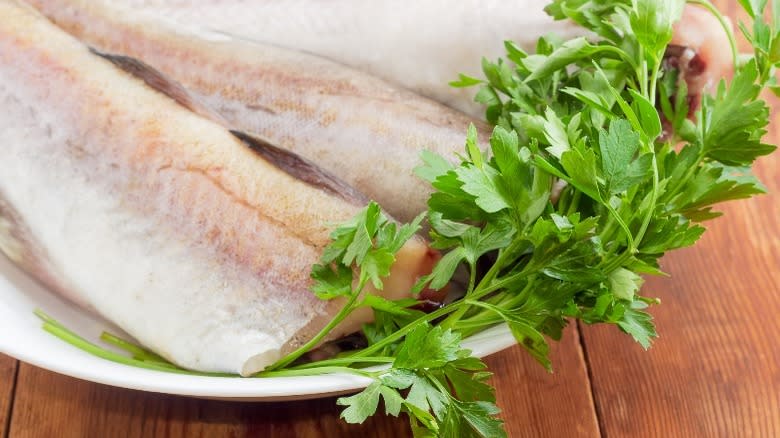
Because we know you're wondering, the answer is yes – White Castle fish sliders are made with real fish. It's processed, like almost every menu item in a fast-food restaurant, but it is actually seafood and not a fish-imitation product.
Specifically, the sliders contain genuine wild-caught Alaska pollock. According to the Association of Genuine Alaska Pollock Producers, the pollock used in the sliders is sustainably fished and contains omega-3 fatty acids.
If you're not familiar with pollock, it will help to know it's a flaky white fish in the cod family. Also known as walleye pollock, Alaska pollock has a taste similar to, but milder than, both cod and haddock. Because it doesn't have a strong taste and isn't very oily, pollock is often used in products like fish sticks and fish burgers.
One piece of good news is that wild Alaska pollock is a recommended choice if you're looking for seafood options that are more environmentally friendly. This North Atlantic saltwater species is sustainably managed and harvested, according to NOAA Fisheries, a federal government agency that regulates marine fishing. And the Good Fish Guide, published by the Marine Conservation Society, rates wild Alaska pollock among its best choices for sustainable seafood.
Panko-Crumb Breading
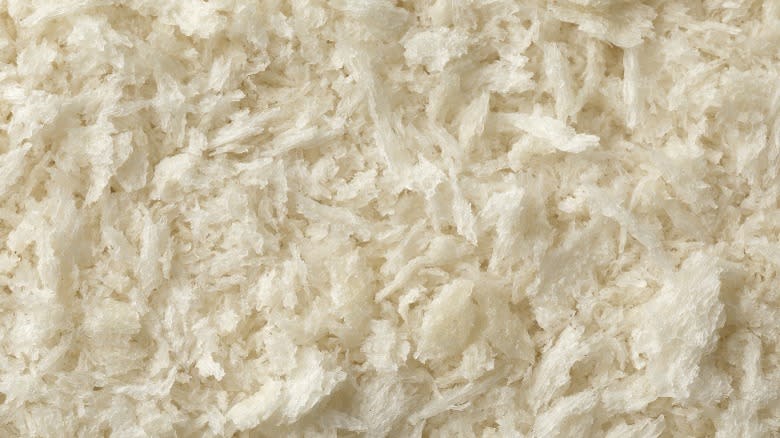
Part of the fish slider's appeal is the crunchy breaded topping, and the way that contrasts with the soft, flaky fish it coats. On White Castle's fish sliders, that topping is panko, a Japanese invention that's become mainstream. If you've had Japanese dishes like katsudon or donkatsu, you've probably had panko.
To make panko, slivers of white bread (crusts removed) are baked with an electric current. This technique for making breadcrumbs developed out of the invention of electric-cooking military field kitchens in the first decades of the 1900s. Post-war, that efficient electric-cooking technology was repurposed for home appliances, according to academic researchers. When this method of electric cooking combined with the increase in wheat exports and the popularity of frozen foods in the 1960s, panko crumbs took off.
The panko breadcrumbs that result from this approach are flaky and crispy. Panko also absorbs less oil than traditional breadcrumb coatings. This makes them a great choice for fried foods, because they stay drier and crunchier. The bread crumbs also simulate the crunch of fried coatings on items that are cooked without oil. White Castle's sliders are famously steamed, so that panko comes in handy.
Questionable Cheese

If you order a fish slider without cheese, it's a dairy-free item. (Keep in mind, however, that like everything else on White Castle's menu, a no-cheese slider is prepared in a common area with dairy ingredients.)
But the fish slider was originally introduced as a sandwich topped with American cheese — and if we're getting technical, that means it's not real cheese at all. According to the FDA, it's actually pasteurized process American cheese food.
The slice of American cheese you can add to your White Castle fish slider is not legally cheese. It's made with real cheese, but it's not cheese itself because it doesn't contain at least 50% pressed curds of milk.
All that said, the processed cheese slices — American and otherwise — used at White Castle do contain real dairy thanks to ingredients like cultured milk, skim milk, and cream. And there are now even more options for dairy aficionados. You can also add cheddar cheese slices to your slider for a smoky taste, or go for jalapeno cheese slices for a bit of a spicy kick.
Omega-3 Fatty Acids
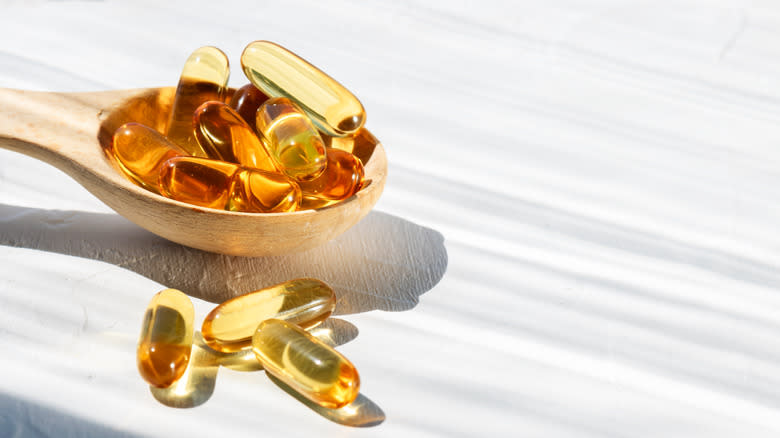
Many species of fish are good sources of omega-3 essential fatty acids, and pollock is one of them. That's good news for fans of the fish slider because according to the National Institutes of Health, omega-3s are important for heart, brain, and eye health. A 2022 meta-analysis published in the Journal of the American Heart Association found that getting 3 grams of omega-3 fatty acids daily from seafood could contribute to a decrease in blood pressure. But unlike cholesterol, our bodies can't produce omega-3 on their own so it's important to get the fats in our diets. Foods like seafood, nuts, and seeds, and supplements like cod liver oil and algal oil are great options.
Two types of omega-3s stand out for their important health benefits: eicosapentaenoic (EPA) and docosahexaenoic (DHA). For healthy adults, getting 200 to 500 milligrams of EPA and DHA omega-3 fatty acids per day is recommended by Alberta Health Services.
Three ounces (cooked) of wild Alaska pollock has 282 milligrams of omega-3 fatty acids, making it a highly nutritious food. However, White Castle's nutrition information doesn't specify how much omega-3 is found in its fish slider, so it's unclear how close the sandwich will get you to your fatty acid intake goals.
Wheat And Gluten

If you can't eat gluten, bad news: White Castle's Panko Fish Slider is off-limits, due to the wheat content in the bun and patty. Like all standard buns at White Castle, the one for the fish slider is made of wheat flour. Additionally, the panko-crumb coating on the fish patty is also made with wheat flour. That means both the bun and patty contain gluten, which contributes to the consistency.
People with celiac disease have to avoid gluten because the protein triggers a serious autoimmune reaction in their bodies (via Celiac Disease Foundation). Other people can experience gastric irritation related to gluten or could be allergic to the wheat grain itself and not gluten specifically. In all of these cases, the way to avoid complications is to avoid eating gluten -- which means the fish slider is a no-no.
In general, gluten-free options are limited at White Castle. Some slider patties might be safe if you can avoid cross-contamination, but the fish slider isn't one of them.
Sodium
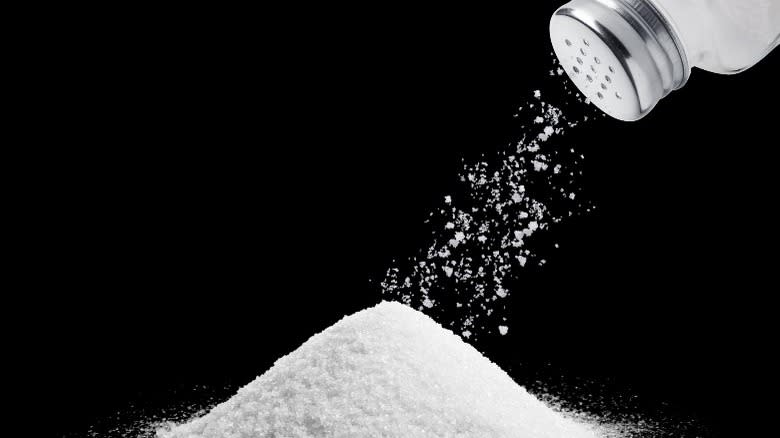
Fast food is known to be high in sodium, which is a problem because most Americans eat more sodium than recommended. The average adult in the U.S. consumes over 3,400 milligrams of sodium daily, according to the Centers for Disease Control — far more than the suggested intake of 2,400 milligrams. The majority of that sodium comes from processed and restaurant foods. Only about 15% of the sodium in our diet is found naturally in foods, while another 11% comes from what we add while cooking, according to the American Heart Association.
With that in mind, you might want to give White Castle's seafood options a pass if you're trying to cut your sodium intake. If you eat a Panko Fish Slider without cheese, you'll consume 320 milligrams of sodium. That's about 13% of the recommended daily intake in just one slider. Adding cheese means another 150 milligrams or so of sodium per slider. Condiments like hot sauce packets (210 milligrams) and barbecue sauce (125 milligrams) can also up those sodium numbers considerably.
Soy
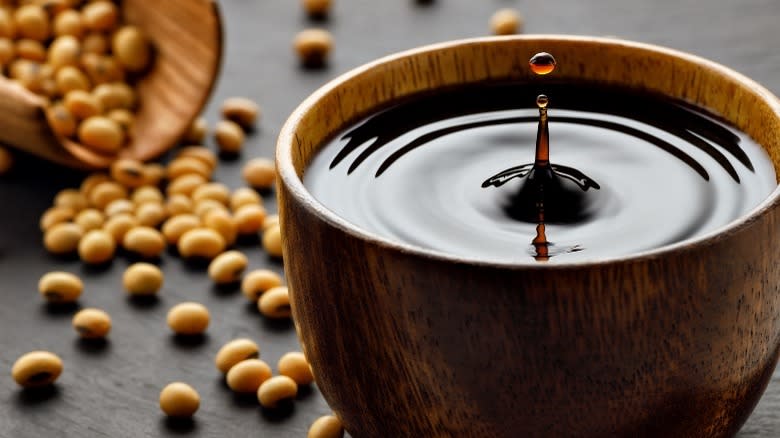
Some foods obviously contain soy: soy sauce, soybeans, and soy milk for example. But soy is also an ingredient in processed foods, which means it can show up in many forms and in surprising places. Processed soy entails removing the hull and fat, taking most of the food's nutritional value with it. Processed food additives like soy lecithin, soy albumin, and textured vegetable protein are potential sources of processed soy to watch for in foods.
The bun used for White Castle's Panko Fish Slider (and other sliders at the restaurant) contains soybean oil, which is made from the seeds of the soybean plant. The fish slider patty itself doesn't contain soy, but cross-contamination is a concern since it is cooked in oil that could be used for foods that do have soy. In addition to allergies, some people are soy intolerant, which means their immune system has a hard time breaking soy down (via Cleveland Clinic). This can lead to indigestion, with symptoms like bloating and gas.
Finally, if you're sensitive or allergic to soy, don't forget to check the ingredient list for condiments and toppings. At White Castle, the processed cheese slices and ranch dressing contain soy.
Cholesterol-Producing Fats
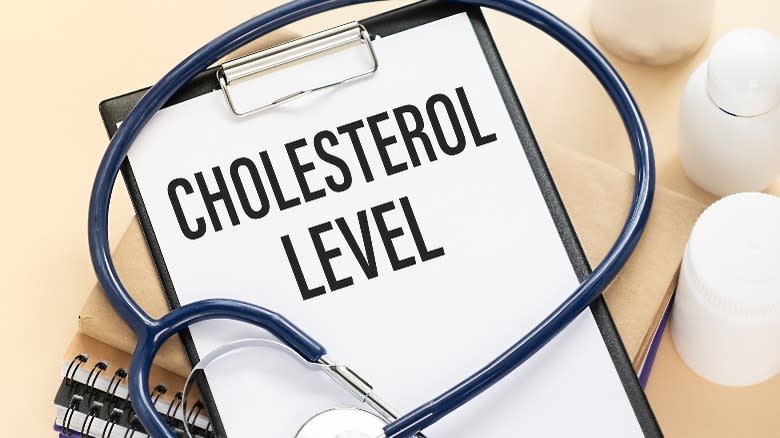
Low-density lipoprotein or LDL makes up most of the cholesterol in the body, according to the Centers for Disease Control. The foods we eat both positively and negatively affect the levels of LDL cholesterol in our blood, per the American Heart Association, which in turn can build up on blood vessel walls and affect our risk for heart attack or stroke. Our bodies need some cholesterol, but we naturally produce all the LDL cholesterol we require. That's why eating excess saturated and trans fats, which can raise our blood LDL cholesterol levels, can be bad for health.
Saturated fats are found naturally in many foods, including meat, dairy, and coconut. On the other hand, trans fats are created when food is processed and are found in some fried and baked foods. White Castle's Panko Fish Slider contains no trans fat, whether or not you add cheese. The menu item does contain saturated fat though: 3.5 grams without cheese, 4.5 grams with American cheese, and 5 grams with jalapeño or cheddar cheese.
That said, the fish slider has less saturated fat than other options at White Castle, including the Double Original Slider, the Double Jalapeño Cheese Slider, or the Panko Surf and Turf with Cheese.
Corn
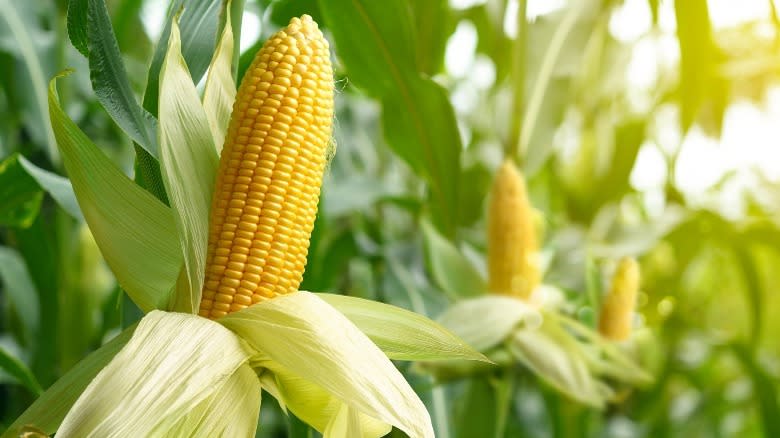
Corn is found in cuisines around the world, but Americans produce and eat more of it than the residents of any other country on earth. This is less due to the fact corn on the cob is a popular side dish than it is to the grain's use in a wide variety of processed foods.
Just as soy can hide in unexpected places, corn is found in several foods where you might not expect it. Corn-based products are used in many processed foods and include corn meal, canola oil, and corn syrup. While corn has nutrients like fiber and protein, refined corn products like high-fructose corn syrup and monosodium glutamate lack most (or all) of these benefits because they are highly processed.
The Panko Fish Slider is no exception to corn's culinary ubiquity, though it's found in the meal in small quantities. Unlike many processed foods, corn is way down on the ingredient list for the fish slider at White Castle. No corn is listed among the ingredients for the chain's slider buns, which are made with sugar instead of corn syrup, but small amounts of modified corn starch and yellow corn flour are used in the patty. Although the slider itself doesn't contain corn syrup, many of White Castle's condiments — including ketchup, honey mustard, and tartar sauce — do.
Sugar
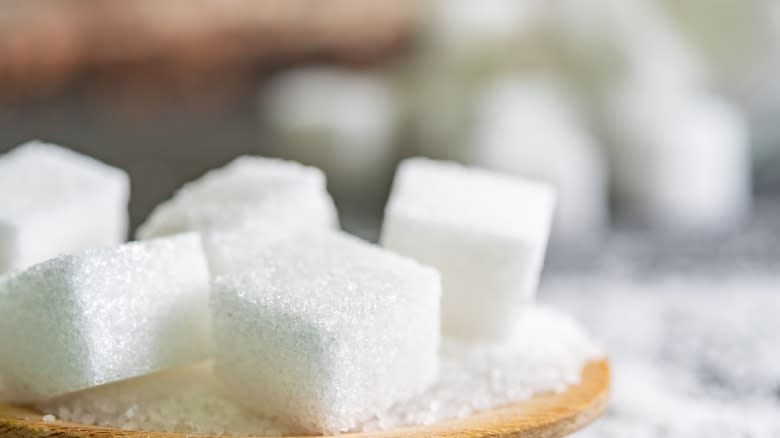
If you've ever tried to cut down your overall sugar intake, you've likely had the frustrating experience of realizing how many processed foods contain added sugar. Some sources — like white sugar, molasses, or maple syrup — are pretty obvious. Others including corn syrup, dextrose, and lactose are easier to miss. In fact, about 13% of the total daily calorie intake for American adults comes from added sugars, according to a national survey of diet published in Nutrients in 2023.
As with many processed foods, the White Castle Panko Fish Slider does contain sugar. However, the good news is that the sugar content is relatively low at just 3 grams per slider, with or without cheese. That's well below other fast-food menu items like Shake Shack's SmokeShack burger or a Five Guys cheeseburger.
But if you're watching your sugar intake, watch out for the condiments you add to your fish slider. A packet of barbecue sauce has 3 grams of sugar, and honey mustard has even more. For a healthier option, choose tartar sauce which only has 1 gram.
Protein
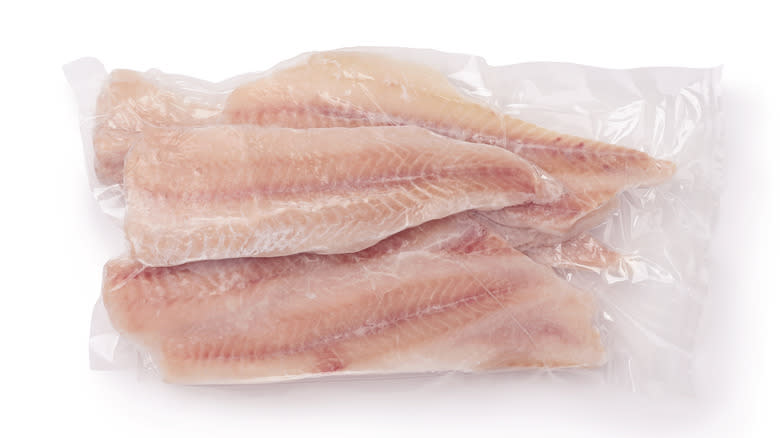
In general, seafood is a great source of dietary protein because it contains complete proteins, with all the amino acids essential for human health in a single food. But pollock, the fish used in White Castle's Panko Fish Sliders, is one of the best fish protein sources. That's because pollock is both low in fat and high in protein, making it a lean source of the essential nutrient. This healthy fish is also low in calories and a good source of vitamin B12, potassium, and selenium.
On its own, 3 ounces of cooked Alaska pollock — the type of pollock used in the Panko Fish Slider — has 20 grams of protein, which is 40% of the recommended daily allowance for adults. As a menu item, the Panko Fish Slider at White Castle has 9 grams of protein, or 11 grams if you add a slice of processed cheese. That's 3 grams more protein than the Original Slider and about 18% of your daily intake for protein in a single burger.
Iron
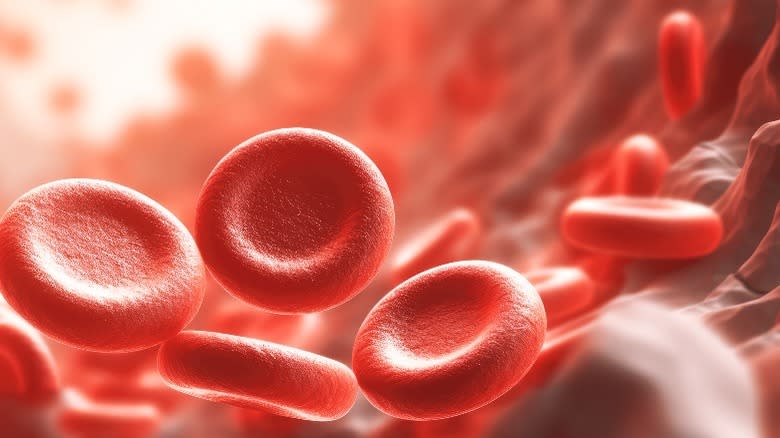
Iron is an essential nutrient needed for healthy growth and development. It's especially important for blood health because it's used to make the components of red blood cells that carry oxygen around the body. In addition to that essential function, iron is also needed for hormone production, immune health, and several other vital body functions, according to the National Institutes of Health.
Foods can contain two kinds of iron: heme and non-heme. Non-heme is found in plant foods like broccoli and nuts. Heme iron is found in animal sources, including fish like pollock, which is used to make White Castle's fish slider.
The fish slider has a decent amount of iron, with 7 milligrams per serving whether or not you add cheese. This is 1 milligram shy of the recommended daily intake of 8 milligrams for men aged 19 to 50 but less than half of the recommended 18 milligrams for women of the same age. However, considering how necessary this nutrient is, every bit counts!
Read the original article on Mashed.


